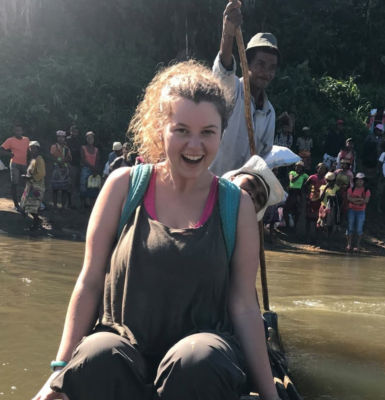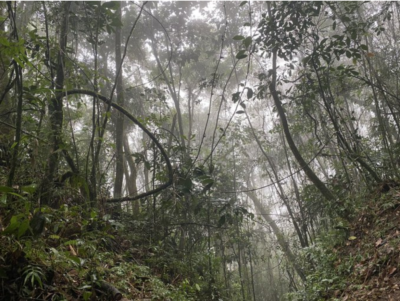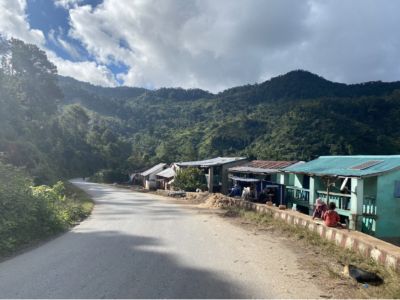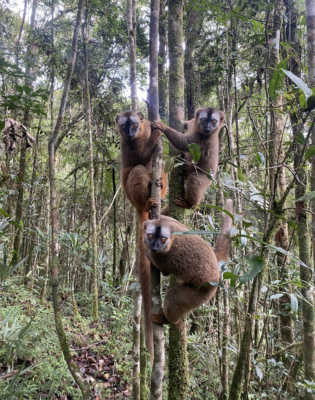Recently Lemur Conservation Network was lucky enough to talk to lemur PhD researcher Mariah Donohue. We discussed her research in Ranomafana, her time in Madagascar during the COVID-19 pandemic, and her undying love for brown lemurs.

About Mariah Donohue
Mariah is a Biology PhD candidate at the University of Kentucky in Dr. David Weisrock’s lab. Broadly, her dissertation explores the causes and consequences of gut microbiome variation in wild lemurs.
Before starting her PhD, Mariah received a bachelor’s degree in Anthropology and a master’s degree in Ecology and Evolution from Stony Brook University as a student of Dr. Patricia Wright of Centre ValBio.
Tell us a bit about your background. How did you find yourself working with lemurs in Madagascar?
It’s crazy to think about it now, but for the first 19 years of my life I’m pretty sure lemurs never crossed my mind!
Stumbling into Lemur Conservation through Study Abroad with Dr. Patricia Wright
I stumbled into this career thanks to Stony Brook University’s general education requirements. When I was a sophomore, I enrolled in Dr. Patricia Wright’s 8:30 AM Primate Conservation course to fulfill a science credit.
Dr. Patricia Wright’s class completely changed the trajectory of my life because, before then, I hadn’t realized it was possible to have a job observing and studying wild animals. So, I joined the next possible Madagascar study abroad trip and that’s when I officially fell in love with lemurs!
Your PhD research is focused on brown lemurs in the eastern rainforests of Madagascar. What exactly are you researching and what are you hoping to find out?

My current project aims to understand whether the gut microbiome – the community of microbes living in the gastrointestinal tract of every mammal – can influence host evolution. In my research, I’m studying lemurs as the host of the gut microbiome.
How Gut Microbiomes Influence Lemur Evolution
The gut microbiome plays a critical role in the host’s digestive, reproductive, immunological, and even neurological functions. Because these functions impact host fitness, a greater understanding of gut microbiome change through evolutionary time could provide new information about how and why populations diverge, form reproductive barriers, and, eventually, speciate. This will help us understand how and why new species of brown lemurs arise!
Amazingly, brown lemurs of southeastern Madagascar offer an ideal natural experiment to explore the link between the gut microbiome and host speciation. I plan to spend a year collecting poops, describing habitats, and recording behavioral data for each brown lemur species in the area.
With this information, I hope to learn whether the gut microbiome drove local adaptation and contributed to hybrid speciation. This will help us understand if and how the gut microbiome affects the hybridisation (or mixing of species) seen in the brown lemurs of southeastern Madagascar.
During the first part of the COVID-19 pandemic you were staying at Centre ValBio in Ranomafana.
Can you talk about this decision to stay in Madagascar during the pandemic? What was it like to live and work at Centre ValBio during this time?

I came to Madagascar in January 2020 on a Fulbright fellowship. Unfortunately, Fulbright was suspended in mid-March due to the Covid-19 pandemic. I was officially supposed to evacuate but it didn’t work out, so I decided to stay at Centre ValBio. Since then, I’ve been involved in two major Covid-19 research initiatives.
Launching a Covid-19 Testing Center at Centre ValBio
For the first, I helped Centre ValBio become a regional diagnostic testing center in collaboration with the health ministry and PIVOT (a local health NGO). We’re currently waiting on all of the necessary reagents, and once they arrive we’ll be able to get a good sense of infection rates and viral spread in our district.
Monitoring Lemurs in Ranomafana National Park
For the second project, I worked with Madagascar National Parks to monitor lemurs in Ranomafana National Park, as genomic evidence suggests many species are susceptible to SARS-CoV-2 infection. For this research, we observed lemurs and collected fecal samples for diagnostic testing. To ensure the safety of the lemurs and my team, we wore masks at all times, maintained a distance of at least 3 meters, and sanitized frequently. We haven’t been able to run any tests yet (still waiting on reagents), but the lemurs look healthy to us!
Living and working in rural areas of Madagascar can be hard at times, but it can also be one of the most enjoyable and rewarding experiences.
What advice would you give to a first time traveller or researcher to Madagascar?

Madagascar’s a really beautiful country with incredible plants, animals, and people.
Step Outside of Your Comfort Zone in Madagascar
To get the full experience, I recommend stepping outside your comfort zone – say yes to toakagasy with village leaders, insanely long hikes, the spiciest sakay, and road trips to different parts of the island. Bring a camera, very resilient raingear, and a ton of Dramamine to help with motion sickness on Madagascar’s rough roads. If you’re a researcher, definitely make sure all of your documents (MNP/CDC/CITES permits and visa) are in order before you arrive. And if you’re in the eastern rainforest, just embrace the leeches!
It’s important to be flexible! Things don’t always go as planned, but if you’re patient and have a good support team, everything usually works out. If you’re planning to do research in southern Madagascar, definitely reach out to Centre ValBio. The staff will help you plan and execute every aspect of your fieldwork.
Lastly, as everyone is itching to know, what is your favourite lemur species and why?

BROWN LEMURS!
Brown lemurs are a group of 7 species within the Eulemur genus. They are medium-sized quadrupeds who spend most of their time in the trees but also travel, eat, and play on the ground.
I was drawn to brown lemurs because there’s still so much to discover about their ecology and evolution. In fact, I’d argue that brown lemurs are quite misunderstood. For example, most people consider them “generalists”, when in reality they’re extremely dependent on fruits. This is problematic because, as purported “generalists”, brown lemurs are assumed to be resilient to human disturbance and therefore receive comparatively less targeted conservation action.
On a more personal level, I just think brown lemurs have incredible personalities. They are super curious, unpredictable, and rambunctious. Plus, they make the cutest grunting sounds.
